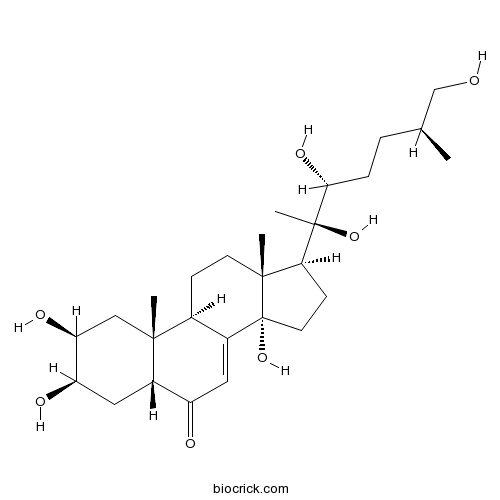25S-InokosteroneCAS# 19595-18-7 |

- Inokosterone
Catalog No.:BCN3431
CAS No.:15130-85-5
- 25R-Inokosterone
Catalog No.:BCN3874
CAS No.:19682-38-3
Quality Control & MSDS
3D structure
Package In Stock
Number of papers citing our products

| Cas No. | 19595-18-7 | SDF | Download SDF |
| PubChem ID | 12358616 | Appearance | Powder |
| Formula | C27H44O7 | M.Wt | 480.6 |
| Type of Compound | Steroids | Storage | Desiccate at -20°C |
| Solubility | Soluble in Chloroform,Dichloromethane,Ethyl Acetate,DMSO,Acetone,etc. | ||
| Chemical Name | (2S,3R,5R,9R,10R,13R,14S,17S)-2,3,14-trihydroxy-10,13-dimethyl-17-[(2R,3R,6S)-2,3,7-trihydroxy-6-methylheptan-2-yl]-2,3,4,5,9,11,12,15,16,17-decahydro-1H-cyclopenta[a]phenanthren-6-one | ||
| SMILES | CC(CCC(C(C)(C1CCC2(C1(CCC3C2=CC(=O)C4C3(CC(C(C4)O)O)C)C)O)O)O)CO | ||
| Standard InChIKey | JQNVCUBPURTQPQ-BMZRUTLMSA-N | ||
| General tips | For obtaining a higher solubility , please warm the tube at 37 ℃ and shake it in the ultrasonic bath for a while.Stock solution can be stored below -20℃ for several months. We recommend that you prepare and use the solution on the same day. However, if the test schedule requires, the stock solutions can be prepared in advance, and the stock solution must be sealed and stored below -20℃. In general, the stock solution can be kept for several months. Before use, we recommend that you leave the vial at room temperature for at least an hour before opening it. |
||
| About Packaging | 1. The packaging of the product may be reversed during transportation, cause the high purity compounds to adhere to the neck or cap of the vial.Take the vail out of its packaging and shake gently until the compounds fall to the bottom of the vial. 2. For liquid products, please centrifuge at 500xg to gather the liquid to the bottom of the vial. 3. Try to avoid loss or contamination during the experiment. |
||
| Shipping Condition | Packaging according to customer requirements(5mg, 10mg, 20mg and more). Ship via FedEx, DHL, UPS, EMS or other couriers with RT, or blue ice upon request. | ||
| Description | 1. 25S-Inokosterone and 25R-inokosterone exhibit potent inhibition (80-95% at ) against TNF-expression levels in A23187 plus phorbol-myrisrate acetate-induced RBL-2H3 cells, they have excellent anti-atopy activity, thus they could be used to a large range of functional anti-atopy cosmetics. |
| Targets | TNF-α | IFN-γ |

25S-Inokosterone Dilution Calculator

25S-Inokosterone Molarity Calculator
| 1 mg | 5 mg | 10 mg | 20 mg | 25 mg | |
| 1 mM | 2.0807 mL | 10.4037 mL | 20.8073 mL | 41.6146 mL | 52.0183 mL |
| 5 mM | 0.4161 mL | 2.0807 mL | 4.1615 mL | 8.3229 mL | 10.4037 mL |
| 10 mM | 0.2081 mL | 1.0404 mL | 2.0807 mL | 4.1615 mL | 5.2018 mL |
| 50 mM | 0.0416 mL | 0.2081 mL | 0.4161 mL | 0.8323 mL | 1.0404 mL |
| 100 mM | 0.0208 mL | 0.104 mL | 0.2081 mL | 0.4161 mL | 0.5202 mL |
| * Note: If you are in the process of experiment, it's necessary to make the dilution ratios of the samples. The dilution data above is only for reference. Normally, it's can get a better solubility within lower of Concentrations. | |||||

Calcutta University

University of Minnesota

University of Maryland School of Medicine

University of Illinois at Chicago

The Ohio State University

University of Zurich

Harvard University

Colorado State University

Auburn University

Yale University

Worcester Polytechnic Institute

Washington State University

Stanford University

University of Leipzig

Universidade da Beira Interior

The Institute of Cancer Research

Heidelberg University

University of Amsterdam

University of Auckland

TsingHua University

The University of Michigan

Miami University

DRURY University

Jilin University

Fudan University

Wuhan University

Sun Yat-sen University

Universite de Paris

Deemed University

Auckland University

The University of Tokyo

Korea University
- (R)-Nepicastat HCl
Catalog No.:BCC4315
CAS No.:195881-94-8
- HTMT dimaleate
Catalog No.:BCC6736
CAS No.:195867-54-0
- 2,6,16-Kauranetriol 2-O-beta-D-allopyranoside
Catalog No.:BCN1509
CAS No.:195735-16-1
- Atrasentan hydrochloride
Catalog No.:BCC1380
CAS No.:195733-43-8
- (+-)-Byakangelicin
Catalog No.:BCN5000
CAS No.:19573-01-4
- 2,16,19-Kauranetriol 2-O-beta-D-allopyranoside
Catalog No.:BCN1510
CAS No.:195723-38-7
- Methyl 4-O-feruloylquinate
Catalog No.:BCC9041
CAS No.:195723-10-5
- Piromidic Acid
Catalog No.:BCC3840
CAS No.:19562-30-2
- AP1903
Catalog No.:BCC5361
CAS No.:195514-63-7
- Chiirirhamnin
Catalog No.:BCN3179
CAS No.:195450-50-1
- Wortmannin
Catalog No.:BCC3874
CAS No.:19545-26-7
- Bay 11-7821(BAY 11-7082)
Catalog No.:BCC2244
CAS No.:19542-67-7
- 17 alpha-propionate
Catalog No.:BCC1296
CAS No.:19608-29-8
- Angelol A
Catalog No.:BCN8036
CAS No.:19625-17-3
- Indole-3-acrylic acid methyl ester
Catalog No.:BCN1190
CAS No.:19626-92-7
- 4-Methoxycinnamaldehyde
Catalog No.:BCN2700
CAS No.:1963-36-6
- Bay 11-7085
Catalog No.:BCC5105
CAS No.:196309-76-9
- Axillarine
Catalog No.:BCN2059
CAS No.:19637-66-2
- Prosaptide TX14(A)
Catalog No.:BCC8020
CAS No.:196391-82-9
- Siegesmethyethericacid
Catalog No.:BCC9248
CAS No.:196399-16-3
- (4S,5R)-3-tert-butoxycarbony-2-(4-anisy)-4-phenyl-5-oxazolidinecarboxylic acid
Catalog No.:BCN8365
CAS No.:196404-55-4
- (RS)-3,5-DHPG
Catalog No.:BCC6613
CAS No.:19641-83-9
- 2S-Amino-3R-octadecanol
Catalog No.:BCN1775
CAS No.:196497-48-0
- 4-Acetyl Ramelteon
Catalog No.:BCC1107
CAS No.:1346598-94-4
High performance liquid chromatography used for quality control of Achyranthis Radix.[Pubmed:22941488]
Arch Pharm Res. 2012 Aug;35(8):1449-55.
To establish a standard of quality control and to identify reliable Achyranthis Radix, three phytoecdysones including ecdysterone (1), 25R-inokosterone (2) and 25S-Inokosterone (3) were determined by quantitative HPLC/UV analysis. Three phytoecdysones were separated with an YMC J'sphere ODS C(18) column (250 mm x 4.6 mm, 4 mum) by isocratic elution using 0.1% formic acid in water and acetonitrile (85:15, v/v%) as the mobile phase. The flow rate was 1.0 mL/min and the UV detector wavelength was set at 245 nm. The standards were quantified by HPLC/UV from Achyranthes bidentata Blume and Achyranthes japonica Nakai, as well as Cyathula capitata Moq. and Cyathula officinalis Kuan, which are of a different genus but are comparative herbs. The method was successfully used in the analysis of Achyranthis Radix of different geographical origin or genera with relatively simple conditions and procedures, and the assay results were satisfactory for linearity, recovery, precision, accuracy, stability and robustness. The HPLC analytical method for pattern recognition analysis was validated by repeated analysis of eighteen A. bidentata Blume samples and ten A. japonica Nakai samples. The results indicate that the established HPLC/UV method is suitable for quantitation and pattern recognition analyses for quality evaluation of Achyranthis Radix.


